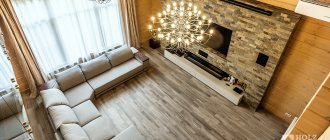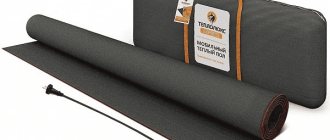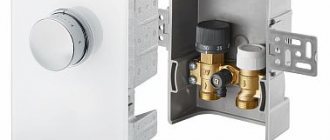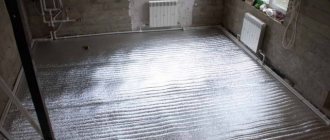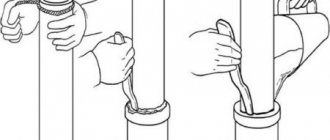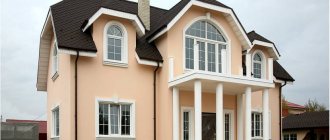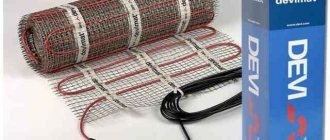In this article we will analyze in detail the installation of a heated floor under an ideal finishing coating for a heated floor. Today, with all the wealth of choice in how to build houses and the choice of building materials, a problem arises: how not to spoil all the beauty of the renovation with a battery hanging on the wall?
Many have already realized that heated floors can help out in such a situation. That's why underfloor heating systems are gaining popularity today. It’s beautiful, or rather, the heated floor system does not affect your interior in any way. Warm floors are economical. Heating costs are reduced by up to 50 percent. Warm floors are great. You can walk around in shorts and barefoot all year round.
About all the advantages of a heated floor system, you need to understand that everything must be done correctly. And choose the right finishing coating for the heated floor. Since not all finishing coatings are suitable for installation on top of a heated floor system.
There are several types of basic flooring:
- Laminate and parquet boards, which have dimensions of 6-12 mm. The materials are laid on plywood or glue.
- Laminate is another type of flooring, the dimensions of which are 0.7-5mm in height. Does not require fixation, just place it on the adhesive base.
- Ceramic tiles are a type of flooring that is used more in bathrooms. The thickness of the product is 5-12 mm. Attached with glue.
- Carpet is a popular type of material with a pile thickness of 4 mm. The pile is made of fabric material, and the thickness of the main coating is 6mm.
- The parquet board measures no more than 20 cm. The main boards fit well with glue.
Installation of water heated floor systems
Underfloor heating, which operates thanks to heating water, is a structure created from a heating circuit, which is usually filled with a cement screed. But a water floor can also be made without the use of cement mortars - this is relevant for those rooms where the floors cannot experience significant loads.
Water heated floor diagram
Floors with concrete screed are the following design (pie).
- Rough subfloor . As a rule, this is a floor or concrete screed on the ground.
- A layer of waterproofing material . It is necessary that groundwater does not penetrate into the room from below. Relevant for rough floors on the ground, and for rooms located on the first floor above the basement.
- Insulation layer. Typically, polystyrene foam is used, which does an excellent job of preventing heat leakage into the ground, floor slab or basement.
Why do you need to insulate underfloor heating?
- Polyethylene layer . Usually laid in two layers. It will not allow water from the concrete mixture to go into the ground or be absorbed into the insulation. By the way, foil insulation, which is popular in the construction industry, cannot be used for these purposes, since the environment created by the action of concrete is very aggressive, and the substances contained in the cement mixture can corrode the material.
- Reinforcing mesh with cells about 5-10 cm . Necessary to strengthen the screed and secure the pipeline.
- Pipes for the heating system. A water circuit is created from it. It is secured with plastic clamps onto a reinforcing mesh. To create a heating system operating on hot water, it is optimal to lay the pipe in increments of 10-30 cm. Clamps are used 2-3 pieces per meter.
Pipe for water heated floor
- Layer of concrete screed . It is poured over the supplied and connected system.
- Substrate . Placed on top of the screed under the floor covering. You can use, for example, foamed polyethylene, isolon, etc.
- Finish coating.
It is the correct choice of the final coating that will be discussed today. It turns out that not every material can be laid on top of heated floor structures.
How individual floor coverings affect the passage of heat from the heating system into the room
It is worth remembering that a warm floor is not a home heating system, it is only an element necessary for a comfortable stay. It is not able to completely heat the room. Surface heating as a result of the heating system cannot exceed +29 degrees. And a water floor cannot be heated by more than +50 degrees. And the level of its heating is quite difficult to regulate - this is influenced by many factors. That is why choosing a suitable floor covering in this case is not as simple as it seems at first glance.
Warm floor
Heated water takes a long time to cool down. If the system is overheated, it will not cool down instantly. Unfortunately, some types of floor coverings react negatively to sudden temperature fluctuations and excessive heating, collapsing and losing performance, and can also begin to release substances into the air that have a negative effect on the human body.
On a note! If necessary, you can quickly cool only the now popular infrared floor. The floor on the water takes a long time to cool down.
Operating principle of IR floor
What is the problem?
But there really is a problem, and our reader’s question sounds absolutely true. Many modern private houses are heated precisely from a water-heated floor, the pipes of which are “walled up” in the screed.
The concrete slab heats up and transfers heat to the entire house (heat, according to the laws of physics, rises from below to above).
But somehow the heat must be transferred from the concrete monolithic slab to the premises of the house. And here the obstacle becomes the floor covering, which must be laid on a rough concrete slab.
Thermal conductivity of floor coverings
There are a large number of different types of flooring, ranging from ceramic tiles to wood. All of them have their own specific properties, among which one of the main ones is thermal conductivity. Before we get acquainted with the thermal conductivity indicators of floor coverings, let’s figure out what kind of concept this is – thermal conductivity. In simple words, it is the ability of bodies or materials to transfer heat . The higher it is, the faster the material heats up, but also cools down faster.
Table. Thermal conductivity coefficients.
| Name of coating | Coefficient value, W/m*k |
| Tile | 1,05 |
| Linoleum | 0,2 |
| Parquet board | 0,15 |
| Carpet, carpeting | 0,12 |
| Laminate | 0,1 |
| Cork | 0,034 |
The lower the thermal conductivity, the longer the coating retains heat. Based on the table, we can conclude that the material that retains heat the longest is cork. Tiles retain thermal energy the worst, but they heat up quickly.
Cork floor
In order for floor heating to be as effective as possible, the finishing material must conduct heat quickly and well. Ceramic tiles are the leader here, although they require fairly powerful heating.
Advice! Solving the problem with heating power is simple - just buy more powerful heaters; The pipe is also laid at more frequent intervals. Heaters with a power rating of at least 200 W/m2 are purchased for tiles.
Floor covering for heated floors
Use of ceramic coatings
The best coating option for this type of floor heating is ceramic tiles. Even with strong heating, it remains the most environmentally friendly material among all those used for the final stage of floor finishing. Also, even with repeated heating-cooling cycles, it does not collapse, has maximum moisture resistance, and is easy to clean. By the way, a high heating rate can also be a disadvantage of using ceramics - it is not always beneficial for the feet. Tiles as a finishing coating for a water floor are the best option for those whose feet are constantly cold and who often catch colds.
Warm floor under tiles
On a note! It is not recommended to install such a covering in a children's room, however, in the bathroom or kitchen, as well as in the hallway, ceramic tiles would be the best option.
In general, tiles of this type can be laid in absolutely any room if the owner is satisfied with it as a covering. It is worth remembering that heated floors are usually installed where there is long-term contact between the feet and the floor.
Tile over heated floor
However, you need to choose ceramic tiles wisely. For example, if the floors in the room will not experience significant loads, then you can lay fairly thin tiles. This will achieve maximum temperature. It is recommended to pay attention to the following indicators when choosing a material.
- Hardness of the material . It is characterized by the so-called ten-step Mohs scale. You can purchase tiles for your apartment that belong to hardness class 5-6.
- Water absorption. In rooms where the humidity level is high, tiles with the lowest value are laid - no more than 3%; for the rest, with the exception of the kitchen, this parameter can be any. For the kitchen, it is recommended to use tiles with a water absorption value of 6%.
Characteristics of floor tiles
- Wear resistance . According to this indicator, the tiles are divided into 5 classes. In rooms where the impact on the floor is insignificant, you can lay tiles of class 2, but in other rooms it is better to use material of class 3 or 4.
- Resistance to chemical reagents . Any tile itself is a fairly durable material in this regard, but this indicator is especially relevant for floors in the garage, kitchen, and bathroom.
Warm floor under tiles
Attention is also paid to the porosity of the material. Experts do not recommend using low-density material.
Laying tiles on water floors is done in this way: the heating system itself is installed, which is then filled with a cement-based screed. Next, the tiles are laid in accordance with the selected pattern and, using a special glue, are glued to the surface of the dried screed. It is important to check the evenness of the rough foundation using a horizontal level. You can turn on the system only after the glue has completely dried, otherwise you can ruin the quality of the work on laying the floor covering.
Laying a warm water floor under the tiles
Prices for popular types of floor tiles
floor tile
Which coating should you prefer?
Today's building materials market offers finishing products from almost all existing types of floor coverings suitable for installation on TP. When choosing them, first of all, you need to focus on the operating temperature of the heating elements in order to ultimately obtain the most comfortable heating of the floor surface. At the same time, the heating system should not operate at the limit of its capabilities. The optimal operating mode should be 80% of the maximum power declared by the manufacturer. It is also necessary to take into account the thermal conductivity of both the finishing coating for the heated floor and all substrates and fasteners, including tile adhesive.
Ceramic tiles, porcelain stoneware, gress, etc.
This type of flooring is ideal for any underfloor heating system. In addition to the fact that mineral materials have good thermal conductivity, they also have high thermal inertia, especially in addition to a thick cement-sand screed. Of course, on the one hand, the inert system will take a long time to warm up and respond slowly to temperature fluctuations. Therefore, it is not suitable for rooms in which rapid heat transfer from the heating system is important, for example, when they are used irregularly (dachas, bathhouses). On the other hand, the denser and thicker the cladding, the more comfortable it will be to be in rooms with constant occupancy, and the operation of heating will be more economical.
Ceramic (and similar) type of flooring for a warm water floor is the best if you plan to use it as the main heat source. Considering the moisture resistance of ceramics, it is optimally suited for installation in kitchens, bathrooms, and dressing rooms. And given the wear resistance of mineral cladding, it will also serve well on surfaces with heavy traffic, for example, in corridors or hallways.
Important! Modern ceramic floor finishing and its installation technologies are suitable for installation not only over warm water floors, but also over self-regulating carbon cables or special types of infrared films.
Features of installing ceramics on TP
When laying ceramic tiles on a concrete screed, it is recommended to use a special cement adhesive with a low level of thermal expansion as a fastening element. If the cladding is mounted directly on the heating elements of a heated floor, then it is better to use epoxy adhesives that have increased elasticity. In this case, the thickness of the adhesive layer must be sufficient to compensate for the thermal expansion of the floor covering. In most cases, to compensate for a coolant temperature of 30-400C, an adhesive layer thickness of 5-8 cm is sufficient. The specific thickness is selected depending on the selected brand of adhesive composition, in accordance with the manufacturer’s recommendations (the operating range of the material is indicated on the packaging).
Important! The use of façade tiles for heated floors is strictly not recommended. It combines a dense front surface with a porous base, which significantly impairs heat transfer.
Laminate
Although the thermal conductivity coefficient of laminate is quite low, it is the second most popular coating for heated floors after tiles. It is recommended to give preference to laminate boards of class 33 and higher, with a thermal resistance not exceeding 0.15 kW/m2. It would be useful to pay attention to the formaldehyde content in it. As a rule, manufacturers claim that the use of laminate flooring with formaldehyde content up to E3 is absolutely safe and acceptable. Nevertheless, it would be useful to use products with an E0 indicator. Despite the fact that its cost is slightly higher, it is more sensitive to humidity, and has a slightly shorter service life, however, health is more expensive in any case.
Features of installing laminate on TP
For laminate boards, technologies have been developed for laying both on concrete pouring and in a dry way on a thick layer of plywood or OSB. Of the damping substrates, special thin sheets (no more than 2 mm) of perforated polystyrene foam have the best thermal conductivity. But it is not recommended to use substrates made of cork or foamed polyethylene, as they have high thermal resistance values.
Important! The best heat transfer performance from a laminate coating can be achieved if it is glued directly to the heating base. But this installation method requires prior leveling of the load-bearing surface, for example, using self-leveling self-leveling flooring compounds.
Wood and wood composite materials
This type of cladding includes parquet, parquet and engineered boards. In the case of using TP coatings made of wood, both their manufacturers and consumers are trying to achieve a certain compromise between aesthetics and optimality. Indeed, from the point of view of heating engineering, wood is one of the least suitable types of raw materials for the production of underfloor heating coatings. It has an insignificant thermal conductivity coefficient, actually being a heat-insulating material. In addition, most wood species widely used in construction have a significant coefficient of temperature and humidity expansion.
Important! To increase hydrophobicity, wood materials are treated with specialized chemicals, which already calls into question the environmental friendliness of the heated floor covering assembled from them.
Varieties of parquet or parquet boards for heated floors with excellent performance and aesthetic characteristics are made from oak, ash or acacia. Firstly, these rocks have the lowest coefficient of thermal expansion. Secondly, after appropriate treatment, they can be used for quite a long period with minimal costs for care and additional maintenance.
The construction market also offers products made from more expensive and exotic woods: rosewood, teak, merbau, iroko, and jatoba. However, many craftsmen are inclined to believe that the best option for parquet flooring over warm floors is bamboo wood materials.
Features of installation of wood materials on TP
- When laying coatings, wood moisture content should not exceed 6-8%. A minimal amount of moisture will significantly soften the drying process, and in the future will practically eliminate the need to seal the lamellas or mask the huge gaps between them with mastics.
- The thickness of parquet elements should not exceed 10-12 mm. The best option, from the point of view of shrinkage deformations, is a parquet or engineered board for a warm floor.
- It is recommended to use polyurethane adhesive as fasteners, which combines high thermal conductivity, moisture resistance, and sufficient elasticity to withstand thermal deformation over a wide temperature range.
- For finishing wood on TP, a two-component epoxy or nitrocellulose varnish is well suited, like any other, the main component of which is synthetic resins (the product must be approved for treating heated surfaces indoors).
- To improve the aesthetics of floor cladding, designers recommend covering it with a dark varnish or using a laying principle called parquet carpet. In this case, the coating is composed of elements of different sizes and textures. Special types of parquet are also often used - with vertical fiber direction. It is also called end flooring or lamella parquet, consisting of transverse cuts.
Important! When caring for TP coating based on natural wood materials, it is not recommended to rub it with various oils or wax. When exposed to temperature, they soften and release volatile components, leaving a specific odor in the rack area.
Polymer materials
This class of floor coverings includes linoleum and PVC tiles, which have appropriate markings that allow them to be laid on heated surfaces of the heating substation. The main thermophysical characteristics of such polymer materials - thermal conductivity and linear expansion coefficient - are comparable to those of an average quality laminate. At the same time, they are also mounted on a substrate made of plywood or OSB boards with mandatory adhesive fastening.
When choosing linoleum or PVC tiles as the final floor covering for a warm floor, you should carefully weigh the pros and cons. After all, the final cost of the entire TP system is considerable, so the feasibility of using budget finishing for its cladding is extremely doubtful.
Important! Despite manufacturers’ assurances about the absolute safety of polymer floor coverings, during their operation a characteristic chemical “aroma” will be felt in the room for quite a long time.
Finishing a water floor with a wooden covering
Natural wood floors have excellent environmental performance. They are pleasant to the touch and durable, which is the reason for their high popularity. However, this is not the best option for a water floor - it is not recommended to heat a wooden base above +27 degrees. Otherwise it will dry out. In general, it is possible to use this type of coating on a water heating system, but it is important to carefully monitor the temperature indicators - the floors should not work at full power.
Water-heated floor under wooden flooring
The same can be said for engineered and parquet boards. By the way, the latter can only be installed in a floating manner. It is better to use a parquet board that is 4 mm thick and has an oil rather than a varnish coating. The engineered board should not be thicker than 16 mm, otherwise it will take a long time to heat up.
Engineering board - features
On a note! Wood coating has low thermal conductivity, which means it will reduce the efficiency of the heating systems themselves. A wooden floor can unwittingly serve as a barrier to the entry of thermal energy into the room.
A wooden floor installed on a water heating system can cause a lot of trouble in the autumn or spring. Due to sudden changes in humidity and temperature, the coating will begin to deform and cracks may appear.
For coverings laid on water-heated floors, it is better to use wood obtained from exotic tree species. Such materials are characterized by higher resistance to moisture, are not prone to shrinkage and have excellent thermal conductivity compared to other rocks. It can be teak, rosewood. But the cost of wood from these trees is quite high.
Installation of a warm water floor
On a note! The boards from which the floor will be made should not be thick, otherwise heat will not penetrate well into the room. However, the best option for heating wooden floor coverings is infrared floors.
Prices for engineered boards
engineering board
Features of choosing a coating for film heated floors
Infrared heated floors are popular in apartments - they are used in hallways, kitchens, small bathrooms and toilets. Dry installation is quick and easy.
The finishing coating should also be laid “dry” using a floating method - it can be laminate, parquet, carpet, linoleum.
But experts recommend discarding tiles due to the fact that the thermal film is not firmly fixed to the base. It is also worth considering that tile adhesive and screed are characterized by the presence of an alkaline environment, which has a destructive effect on the thermofloor - the result can be a short circuit.
Laminate
Popular types of flooring include laminate. The material has excellent thermal conductivity, is resistant to various chemical influences, but is afraid of moisture. Also, when choosing this material, it is worth buying a laminate that is suitable specifically for laying on heated floors - it is marked with special symbols and must be at least 32 strength classes. Slats without markings cannot be laid on heated floors. The thickness of the laminate for laying on the floor should be no more than 8-10 mm.
Warm floor under laminate
It is also important to place a special underlay under the laminate if it is laid on a water floor. But in any case, heating the material above +30 degrees is not recommended. Most often, the laminate is laid on an IR film floor.
Attention! Cheap laminate cannot be used on heated floors, and the slats cannot be heated too much. This is due to the fact that the material is capable of releasing formaldehyde, a dangerous carcinogen, into the environment at high temperatures. Thus, indoor air becomes unsafe for health. Symptoms of formaldehyde poisoning are headaches, nausea, cough, etc. Laminate with the lowest formaldehyde content is marked with the designations E1 and E0.
Prices for Tarkett laminate
Tarquette laminate
Laminate as a covering for heated floors
It’s definitely not worth laying regular laminate flooring on a heated floor. The point is not only that it will conduct heat poorly. The point is that it is not designed for operation at elevated temperatures. Nobody can tell you what will stand out there. It was simply not tested in this mode (at temperature). And since the material is clearly not natural, something will stand out. And how films/paints will react to heating is also unknown. There have been cases when laminate flooring on a dark floor turned dark. And the joints come apart and begin to creak.
Laminate as a covering for heated floors is quite popular
So it’s not for nothing that a special laminate for heated floors has a much higher price. Firstly, its base is multi-layered and the layers have different directions. This is necessary so that the dimensions change as little as possible with changes in temperature and humidity. And the materials used are those that do not respond to increased temperatures. They do not darken, do not fade, do not smell, and expand and contract to a minimum. And the locks have been designed to be more reliable and do not come apart when heated. So, although there are no external differences, in fact they are quite significant.
And one more thing: laminate as a finishing coating for a warm floor requires a special substrate. The usual one smooths out micro-irregularities and performs the task of sound insulation. And if you use cork, it also improves the thermal insulation slightly. And the substrate under the laminate for a warm floor, on the contrary, has good (better than all others) thermal conductivity properties. So it’s not the same as for regular laminate.
Advantages and disadvantages
If we talk about heated floors in rooms, the choice is very small. These are laminate, wood and engineered board. You can also add quartz vinyl, but it is from the category of “hard” coatings. Of all these materials, laminate and quartz vinyl are the easiest to install. Moreover, only laminate can be disassembled and reassembled during operation. All other coverings are glued or nailed and dismantling them is problematic. The second advantage of laminate is its lower cost. Even though laminate flooring is much more expensive than regular flooring.
If laminate is laid on a heated floor, it will conduct heat, but not as well as tiles or even wood
The disadvantage is that the thermal conductivity is not very high. This figure is lower than that of wood and linoleum. And also the presence of a substrate. So if we talk about heating efficiency, then laminate as a covering for a heated floor is not the best choice.
Linoleum on warm floor
This type of coating is also one of the most popular types of finishes. It is used quite often, but can it be laid on warm water floors? So, for laying on the heating system, you can only use natural linoleums (marmoleums) or those made of PVC (vinyl). The second type is a cheaper option.
Linoleum
At the same time, there should be no insulation on the linoleum, since the thermal conductivity of such material is quite low. And in general, linoleum should be chosen with a minimum thickness.
How to choose a coating?
Let's summarize all of the above and answer the question - what type of finishing coating should you choose? For heated floors on water it is not recommended to use:
- coatings created on the basis of bamboo raw materials;
- low-quality and thick linoleum;
- classic parquet.
On floors that are heated by water, you can lay a certain type of laminate or carpet. They retain heat well, but it is important to ensure that the material does not overheat. This is the best option for bedrooms and living rooms. PVC-based coverings can also be laid over floors. Although such materials usually do not look very presentable.
Warm floor under laminate
Ceramic tiles are the best option, but they will not look good in a bedroom or nursery. But in the kitchen or bathroom it is irreplaceable.
In general, the choice of flooring will depend on a huge number of factors - the purpose of the room, operating conditions, the functionality of the entire heating system of the house or apartment, the strength of the coating, etc. The best option is to cover the hall and rooms with carpet or laminate, and in the kitchen, bathroom , bathroom and hallway, cover the heated floors with tiles.
Video - Coatings for heated floors
Advantages and disadvantages of tiles for heated floors
When the floor heating is turned off, the tiles cool down and become cold.
If we summarize the performance characteristics of underfloor heating, we can highlight the characteristic pros and cons inherent in all types of materials that are used in residential premises.
Advantages include:
- strength;
- waterproof;
- good thermal conductivity;
- variety of textures;
- wide choice of colors;
- ease of installation;
- durability;
- dielectric qualities;
- ease of cleaning from dirt.
The material also has its drawbacks. The main thing is the presence of seams that are visible visually and felt to the touch. When the heater is turned off, tiles and porcelain tiles become cold and unpleasant to walk on. The tiles crack when hard objects fall on them. If there is no stock, replacement can be a major hassle.
Making a water heated floor
Step 1. The rough base is thoroughly cleaned. Debris is removed and dust is removed using a construction vacuum cleaner.
Preparing the subfloor
Step 2. A layer of waterproofing material is laid. Individual strips of waterproofing are connected to each other using tape. Insulation is laid on the surface. If the waterproofing is under the screed, then it does not need to be re-installed.
Laying insulation
Step 3. The insulation boards are fixed to the floor using special “fungi”, holes for which are drilled with a powerful drill or hammer drill.
Drilling holes for "fungi"
Insulation boards are attached to the floor
Step 4. A reinforcing mesh is laid on the surface of the insulation and secured using “fungi”. The mesh is laid with an overlap in 1 cell, and the individual webs are fastened to each other using plastic clamps.
Connecting reinforcing mesh sheets
Drilling holes for fasteners
Fixing the reinforcing mesh
Step 5. A manifold is installed to which the water floor pipes will be connected. The collectors are wall mounted.
Installed floor heating collector
Step 6. A special compensation tape is attached to the wall along the floor to compensate for the thermal expansion of the screed.
Compensation tape
Step 7. In accordance with the laying diagram, the pipe for the heating circuit is laid on the reinforcing mesh and secured to it using plastic clamps.
Laying pipes for a heated floor circuit
Heated floor pipe circuit length calculator
Go to calculations
Step 8. Pipes are connected to the collector. Before pouring the screeds, they are filled with water.
Connecting pipes to the collector
Step 9. Beacons are installed on the floor. The beacons are leveled using a construction laser level. It is important to remember that the thickness of the screed, starting from the level of the pipes, should not be less than 4 cm.
Beacons installed
Step 10. The cement screed is poured in accordance with all the rules. After it has completely dried (about 28 days), the selected floor covering can be laid on the floor. You cannot turn on the heated floor until the screed is completely dry.
The screed is poured
SNiP 2.03.13-88. Floors. Downloadable file (click the link to open the PDF in a new window).
SNiP 2.03.13-88
Video - Warm floor under laminate
Video - Installation of water heated floor
Warm water flooring cannot be installed in all rooms. For example, in old houses the load on the heating system due to it can be very high, and the housing and communal services organization may prohibit connecting the system. However, in new buildings there is usually a separate tap for connecting such a system and there will be no problems with organizing heating. Also, a water floor can be installed in cottage-type houses. And you will have to choose the coating according to your taste.
Installation methods for selected elements
Installation methods vary significantly depending on the composition and shape of the underfloor heating elements. All cases have one thing in common - high-quality leveling of the base and its primer to improve adhesion.
Tiles and porcelain tiles are laid on glue, the basis of which is cement. It is possible to use mortars packaged in tubes; it is faster, easier, but more expensive. Laying is done in even rows, offset or diagonally. Alignment is achieved using plastic crosses. After the solution hardens, they are removed and the seams are rubbed down.
Polymer fragments are fixed to the slab on an adhesive base end-to-end or attached in a floating manner directly to the screed. In this case, gluing is performed only along the chamfers on the edges of the products.
